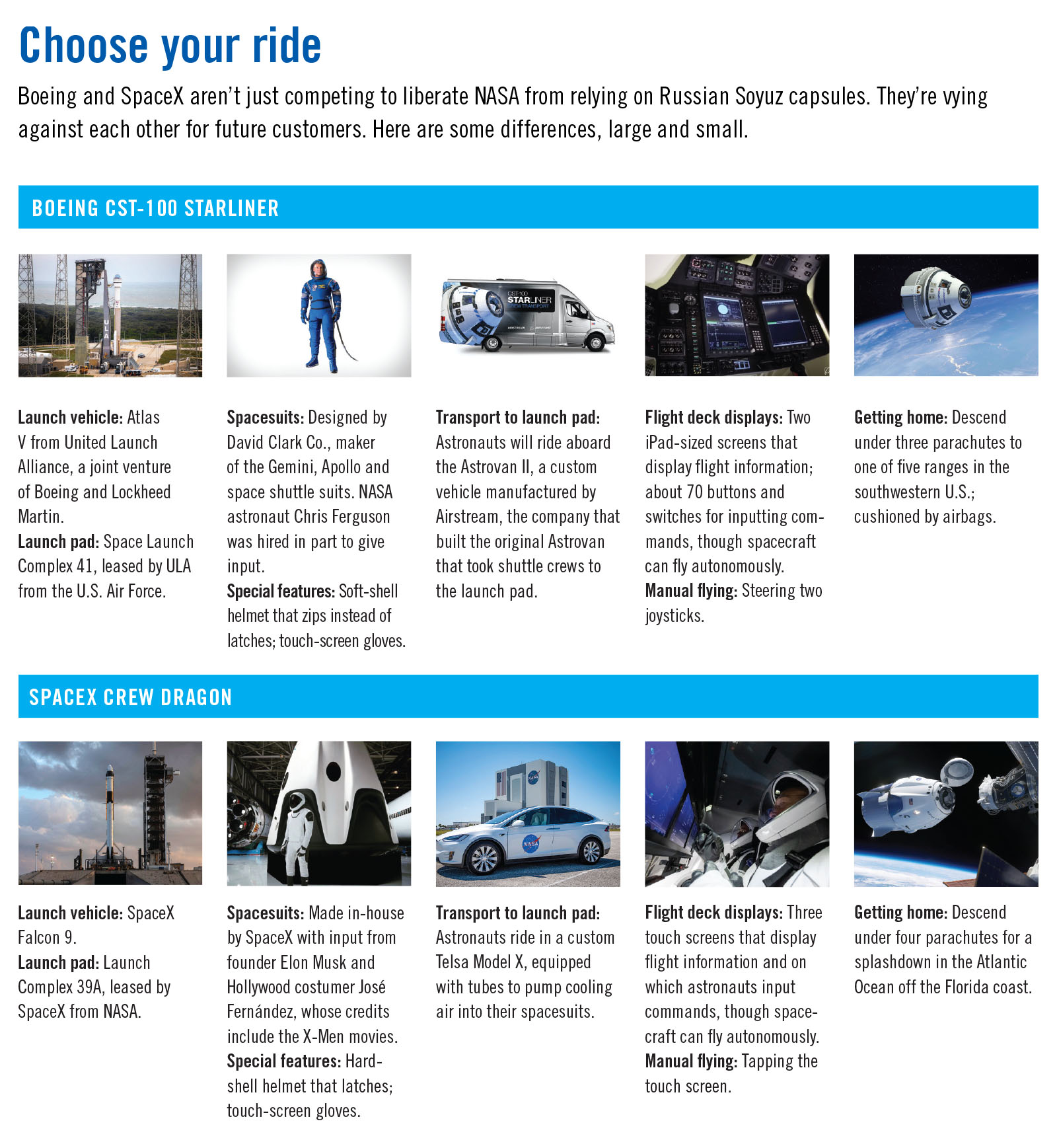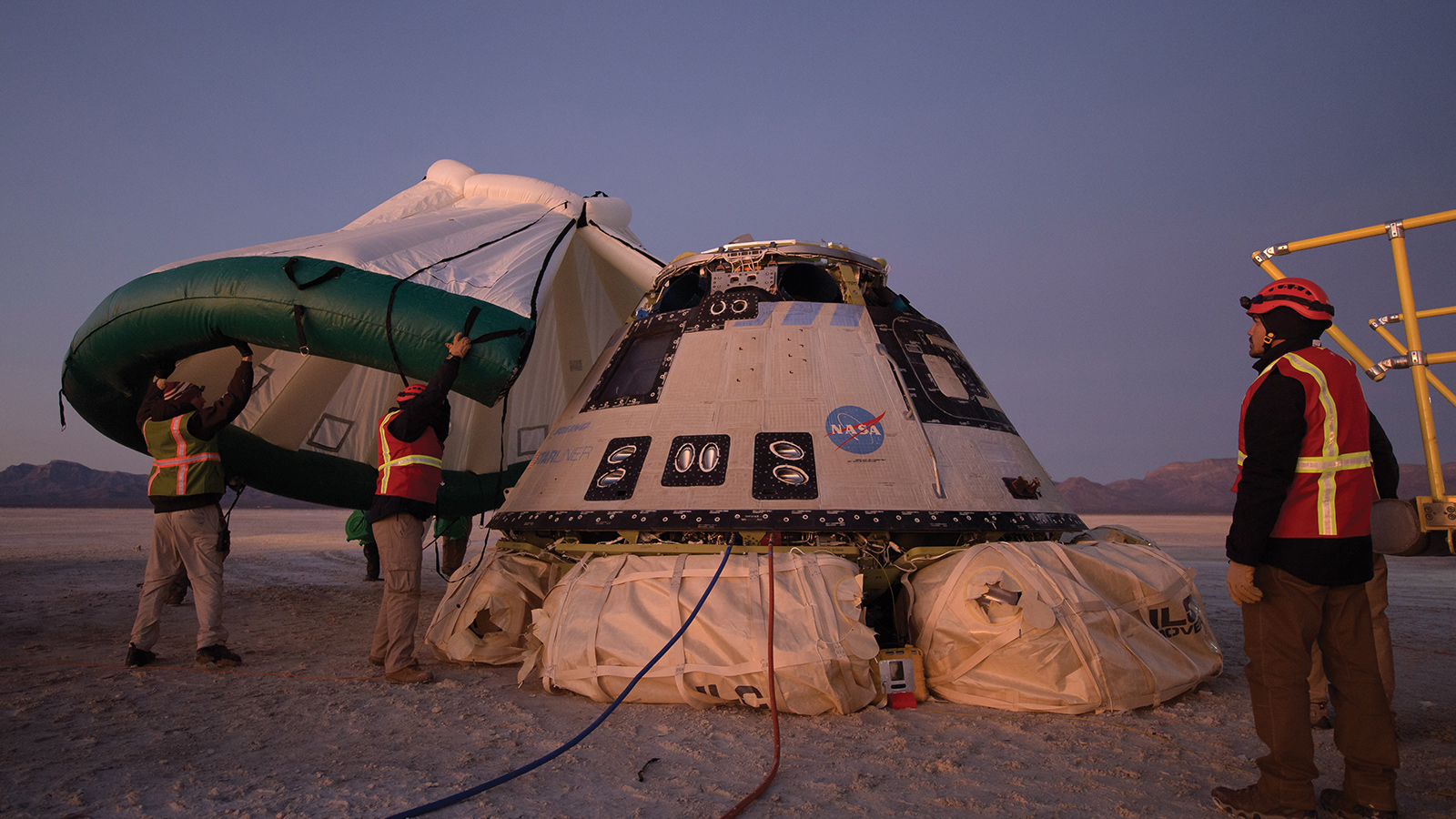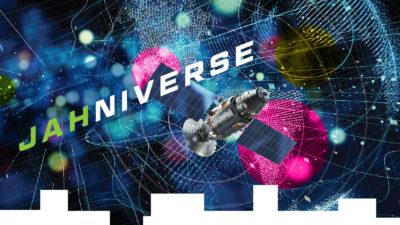Shopping for a spaceship
By Cat Hofacker|July/August 2020
Now that SpaceX has proven it can launch NASA astronauts to the International Space Station, Boeing is preparing for its turn, likely early next year. When astronauts climb inside Starliner, space enthusiasts and casual viewers alike will notice some differences that could help future passengers decide which capsule they’d rather book for a trip to space.
For those accustomed to space shuttle launches and those of the Apollo era, the first SpaceX crewed mission was simultaneously familiar and totally new.
NASA astronauts Bob Behnken and Doug Hurley walked out of Kennedy Space Center in Florida on the way to the launch pad on May 30 through the same doorway as the Apollo and space shuttle crews before them, but did so donned in sleek white and black suits instead of the puffy white suits of Apollo or the neon orange ascent suits of the shuttle era. They were the latest in a long line of astronauts to traverse to Launch Complex 39A, but the first to make the 14-kilometer trek in a zippy Tesla Model X. And when they stepped into the SpaceX Crew Dragon capsule, they were greeted by three glossy touch screens, a sharp contrast to the array of buttons and switches on the shuttle flight deck.
These technology choices exemplify the beginning of what NASA Administrator Jim Bridenstine called a “new era in human spaceflight.” Design decisions were entirely up to SpaceX, as long as they met NASA’s requirements for crew safety. SpaceX owns the Crew Dragon that’s docked at station and due to carry Behnken and Hurley home in August; it built the Falcon 9 that boosted them; and it leases Pad 39A from NASA. Over the course of NASA’s $8.2 billion Commercial Crew development program ($3.14 billion of which went to SpaceX), NASA astronauts were invited to sit in a mockup of Crew Dragon and give feedback, but neither they nor NASA had veto authority. SpaceX did have to convince NASA that all safety risks were acceptable from the pad to the station. This was accomplished through extensive testing of the capsule, including parachutes; the addition of launch abort engines that could whisk the astronauts away from a fizzling or exploding launch vehicle provided further assurance, as did a 2019 uncrewed flight in which Dragon autonomously flew and docked with the International Space Station.
Soon, if all goes as planned, NASA, the space agencies of other governments and someday private customers will choose how they want to ride to ISS or any of the proposed private stations still to be erected. NASA’s goal has been to spark creation of a competitive human launch market, and that can’t happen unless Boeing establishes its CST-100 Starliner capsules as a viable competitor to the Crew Dragons.
To do that, Boeing must try again to dock an uncrewed Starliner to the station, after the first demonstration attempt in December, called OFT for orbital flight test, was aborted in orbit. A software coding error caused the Mission Elapsed Time clock to start too early, which threw out of sync the planned orbital insertion burn needed to put Starliner on the path to intersect with the space station. Boeing had no choice but to order the capsule home without doing the burn. NASA and Boeing have said only that the second uncrewed flight will be later this year, which likely pushes the first Starliner crewed flight to 2021.
“This really does illustrate the advantage of having two partners,” Phil McAlister, NASA’s director of commercial spaceflight, told the Human Exploration and Operations Committee of NASA’s Advisory Council in May. “Knowing there is another partner there to take up the slack allows for both companies to focus on crew safety.”
Both designs must prove their safety, so analysts and former astronauts suspect that other factors, such as the capsule interior and spacesuit designs, will be powerful determinants for the kinds of customers who are likely to choose each of the competing capsules.
“People will sign up with SpaceX who are more on the ‘showy’ side of things because that’s more of a headliner,” predicts Laura Forczyk, founder of space consulting firm Astralytical in Georgia. “Boeing has the more traditional [customer set], other government agencies who want to fly astronauts.”
Boeing declined to discuss this or other issues, citing the need to focus on preparations for the second uncrewed flight, dubbed OFT-2. A spokesman directed me to previous comments by Jim Chilton, head of Boeing’s Space and Launch division.
“Boeing stands ready to repeat an OFT,” Chilton told reporters during a March press conference. “We just want to make sure that whatever we fly next is aligned with NASA’s preferences. And of course, for all of us, crew safety is No. 1.”
Different philosophies
The Crew Dragon and Starliner designs are significant upgrades from that of the Apollo-era capsules and space shuttle orbiters in terms of safety, software and reusability. Both vehicles are designed to fly autonomously from launch to docking, although the spacecraft commander can intervene if there’s a technical failure. Boeing will alternate between two Starliner capsules, each intended to fly up to 10 times after refurbishment. The size of the Crew Dragon fleet is still unclear because until May, NASA had required that SpaceX use a new capsule for every flight.
Where these spacecraft diverge is the underlying philosophy guiding their development.
“I think the big difference is that SpaceX paid attention to the look of the design as part of the engineering process,” says Garrett Reisman, a former NASA astronaut who worked at SpaceX from 2011 to 2018 and was in charge of Crew Dragon design and development. He remains a senior adviser on topics relating to human spaceflight.
In contrast, Boeing opted for upgrades, not an overhaul, of “flight proven and heritage” technologies where possible, to cut down on schedule and risk to the crew, according to the Boeing website.
The two distinct pressure suits that Dragon and Starliner crews will don for launch and landing exemplify these approaches.
Along with meeting NASA’s requirements for a flame-resistant suit that would also protect crew in the event of a cabin depressurization, SpaceX founder Elon Musk wanted a garment that looked stylish.
“He’s trying to get the entire world excited about a hopeful, promising future in space for all of humanity, and to do that, it’s got to look good,” Reisman says. “People are going to get excited about a future that not only is cool but also looks cool.”
To meet this goal, Musk enlisted Hollywood costume designer José Fernández in 2016 to create the first prototypes. From there, SpaceX designers tweaked the suits to balance aesthetics and functionality.
The Boeing suits, by contrast, were made by David Clark Co. of Massachusetts, the same company that made the Gemini, Apollo and space shuttle suits.
Boeing set out to create a lighter, more compact garment than those earlier suits. Designers relied on feedback from former NASA astronaut Chris Ferguson, hired by Boeing in 2012 as director of crew and mission systems for Starliner. Ferguson will join NASA astronauts Nicole Mann and Mike Fincke for the capsule’s crewed demonstration.
The Crew Dragon and Starliner suits, each of which will be custom-made for crew members, both weigh in at 9 kilograms, compared to the 13.6-kilogram shuttle suit. The weight reduction comes partially from the fact that neither design has the bubble-shaped helmets of the shuttle era that locked onto the suits via heavy, metal neck rings. Instead, Boeing opted for a soft, hood-like helmet that astronauts can zip shut, whereas SpaceX 3D-prints its suit helmets out of an undisclosed material.
Once seated in their Starliner capsule, astronauts can adjust horizontal zippers on the suit torso for comfort and pull off their gloves if need be, a contrast to the one-piece Crew Dragon suit with attached gloves. The only adjusting those crews can make is flipping up their helmet visor.
“We like to think this represents the future of what protective space gear will be,” Ferguson said during a 2017 Facebook Live of the suit’s unveiling.
Getting to the launch pad
In another nod to the shuttle program, Starliner crews will make the 14-kilometer ride to Pad 41 in a customized silver motor coach dubbed the Astrovan II, built by Ohio trailer company Airstream, which crafted the original Astrovan to ferry shuttle astronauts to the launch pad.
The flight decks through which the astronauts will monitor the status of their Starliner is another notable differentiator. Instead of the three large touch screens in Crew Dragon, the Starliner console has two iPad-sized screens surrounded by about 70 physical switches and knobs.
Dragon’s touch screens gave the flight deck a futuristic look for the estimated 10 million people who watched the capsule rise from the pad and dock 19 hours later in near-real time. Most astronauts pride themselves on valuing function over form in such matters.
“I do think we have the obvious reaction: ‘Wow, isn’t that slick,’” says former astronaut Tom Jones, who flew on four shuttle missions between 1994 and 2001. “But whether or not you touch the screen or press a button at the edge of the screen, I don’t think it makes much difference to you as an operator.”
Boeing’s Ferguson will get to test Starliner’s version of the controls on orbit. The capsule is designed to fly and dock with ISS autonomously, but Ferguson and future crew members must be ready to manually steer the spacecraft if the need arises by maneuvering joysticks on both sides of the screens. During the Crew Dragon flight, spacecraft commander Hurley overrode the automated flight software with a few taps of the touch screen to inch Dragon within 100 meters of ISS.
As different as the Crew Dragon and Starliner flights will look almost from the start, the biggest technical difference won’t come until the end of the mission. Instead of the parachute splashdown in the Atlantic Ocean favored by the Apollo and Crew Dragon capsules, Boeing decided to bring Starliner down to one of five ranges in the Southwest United States, based on where the space station is in its orbit when Starliner crews depart.
Starliner’s return will start out much like Behnken and Hurley’s planned trip home in Dragon. The capsules will undock and jettison their service modules, revealing heat shields that will plow into the atmosphere and ablate to protect the capsules from the searing 1,600 degrees Celsius of entry.
That’s where the architectures diverge. Starliner has three parachutes to slow it upon entry, while the heavier Crew Dragon needs four. To cushion the landing, Starliner will inflate air bags with compressed nitrogen and oxygen gas.
“One of the main benefits is the stability and the ability for the landing system to absorb the loads on the crew and on the spacecraft,” said John Mulholland, then Boeing’s Commercial Crew program manager, during a December press conference.
Boeing says coming down on land will also make refurbishment easier because recovery teams won’t have to fish the capsule out of the sea and take it back to a port as SpaceX does.
Come fly with me
The NASA test flights of Crew Dragon and Starliner will serve as benchmarks for attracting future customers, without which Boeing and SpaceX can’t close their business cases. Forczyk of Astralytical and other analysts remain uncertain there is enough demand to merit two crew transportation systems. The NASA contracts cover only six routine flights to ISS in the coming years, each with four astronauts.
“That can’t be your only market,” says Marco Cáceres, space analyst for aerospace consulting firm Teal Group of Virginia. “If you’re going to do something in terms of human space exploration, it’s got to be much broader than sending astronauts one, two or three times a year to the space station.”
Boeing is advertising a fifth open seat on its NASA flights to outside customers, and both companies are brokering private flights on their capsules through space tourism company Space Adventures.
So far, only SpaceX has had any luck. Space Adventures earlier this year announced it will launch four private citizens aboard a Crew Dragon for a five-day orbital trip, tentatively scheduled for 2021. Dragon garnered a second private customer in March, when Texas startup Axiom Space signed a contract to launch a crew of three tourists and an Axiom astronaut on a Crew Dragon for an eight-day stay at ISS, also targeted for 2021.
If all goes as planned, Axiom could blossom into a lucrative customer. Under a NASA contract, the company is building a commercial habitat module, scheduled to be installed on ISS by 2024. This is the first of several private nodes Axiom aims to build and eventually detach into a separate space station.
Boeing’s path forward commercially is more challenging. The company must address the coding errors and other recommendations laid out by an independent review panel earlier this year before it launches the next crewless mission, all of which is paid for through a $410 million charge on 2019 earnings that Boeing set aside in 2020.
The stakes are high for the next attempt.
“Boeing probably needs to prove itself because if they can’t, if they experience more significant delays and setbacks, they run the risk of being completely overshadowed by SpaceX,” Forczyk says.
Related Topics
Human Spaceflight"People will sign up with SpaceX who are more on the ‘showy’ side of things because that’s more of a headliner. Boeing has the more traditional [customer set], other government agencies who want to fly astronauts.”
Space consultant Laura Forczyk










